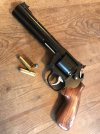One thing I hear s lot about revolvers is that you can't really hurt them, or they are stupid simple, and nothing to go wrong.
This is not really accurate. There are some pretty tight tolerances and small, often delicate machines parts that make them run.
The pawl arm and star to advance the cylinder is a pretty small, delicate arrangement. I've had a like new S&W go out of time just from practicing on cheap snap caps. The practice snap cap had brass primers on springs to protect the hammer. After a little bit one of the 'primers' was protruding a bit, and catching on a machine mark. Just a few nights of practice caused the star to get worn enough that the cylinder would go out of time and not lock up on one chamber when the trigger or hammer was pulled slowly. It was an easy, cheap fix by a gunsmith, but worth noting.
Also, idiots who like to snap the cylinder closed like in movies, or spinning the cylinders fast then snapping it closed. Lots of ways to spring the cylinder, or ruin then lockup.
I took a good friend shooting. He was a SWAT trained officer. But not a revolver guy. First thing he did was snap the cylinder closed with an action movie wrist snap. I had to educate him that you can bend the yoke doing that........and that absolutely anyone who saw him doing that, thst knew anything about revolvers wouldn't appreciate it.
So when I look at used revolvers, I like to check to make sure the lockup is good, the timing is in order. Look for a sprung or bent cylinder alignment, and for indications that the cylinder, extractor or crane group are bent.
Single actions are just as easy to mess up playing "quick draw cowboy".




